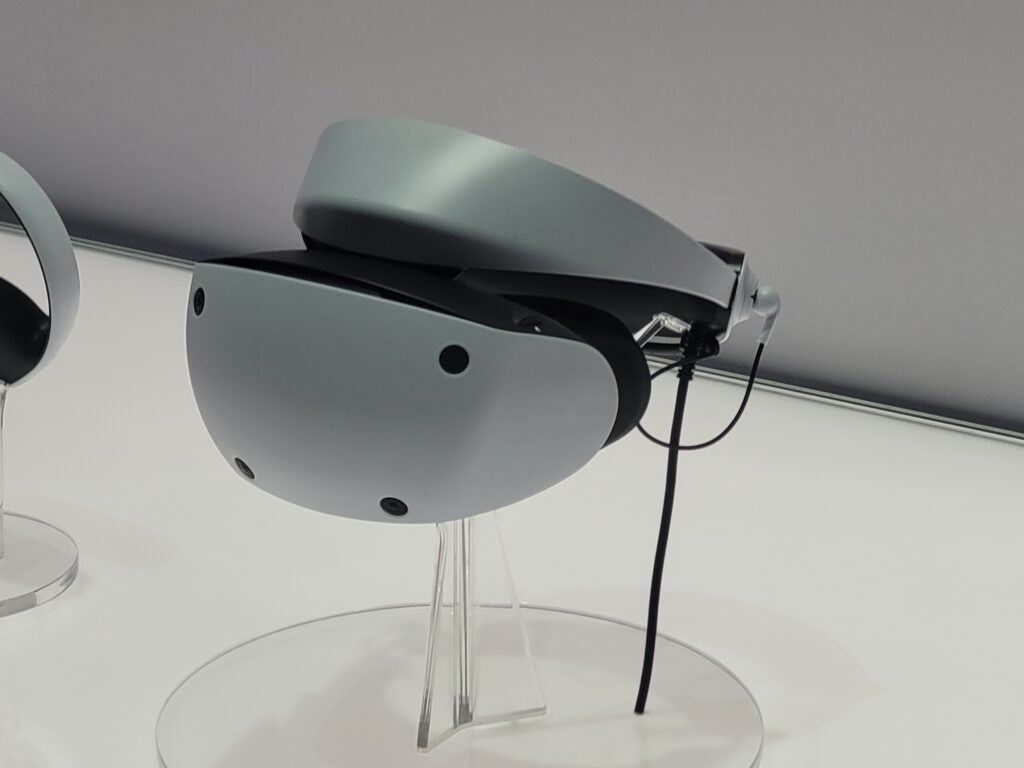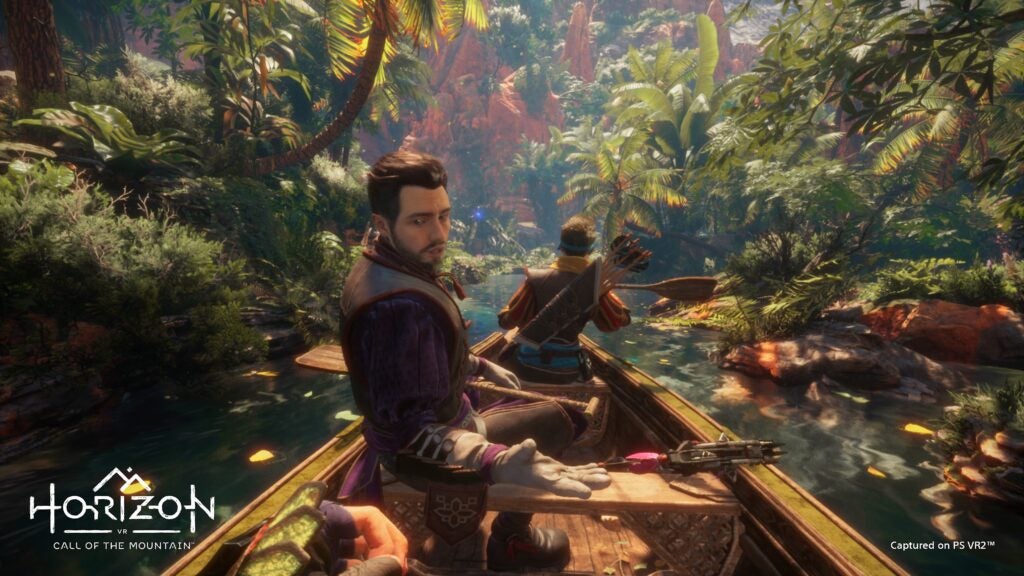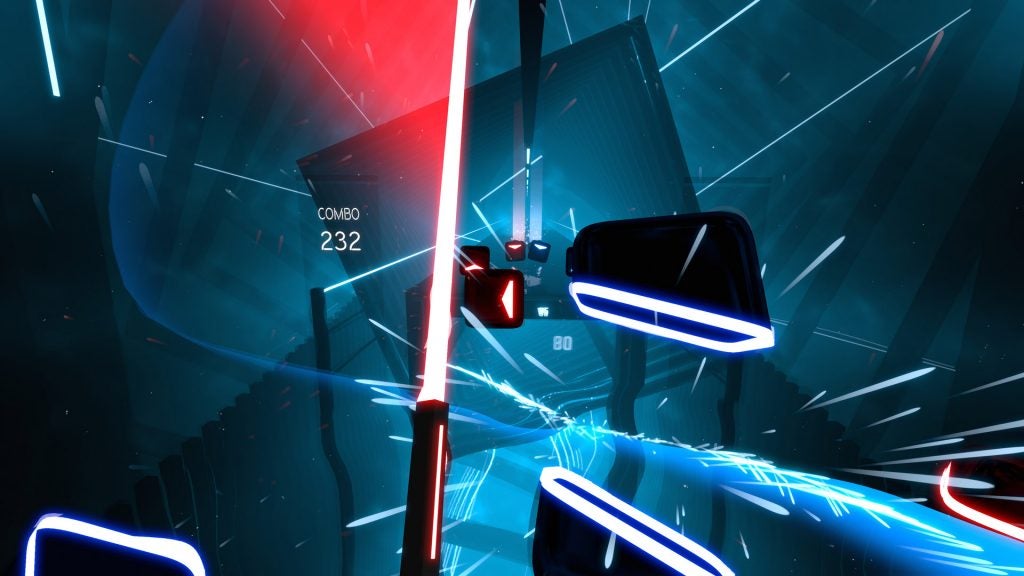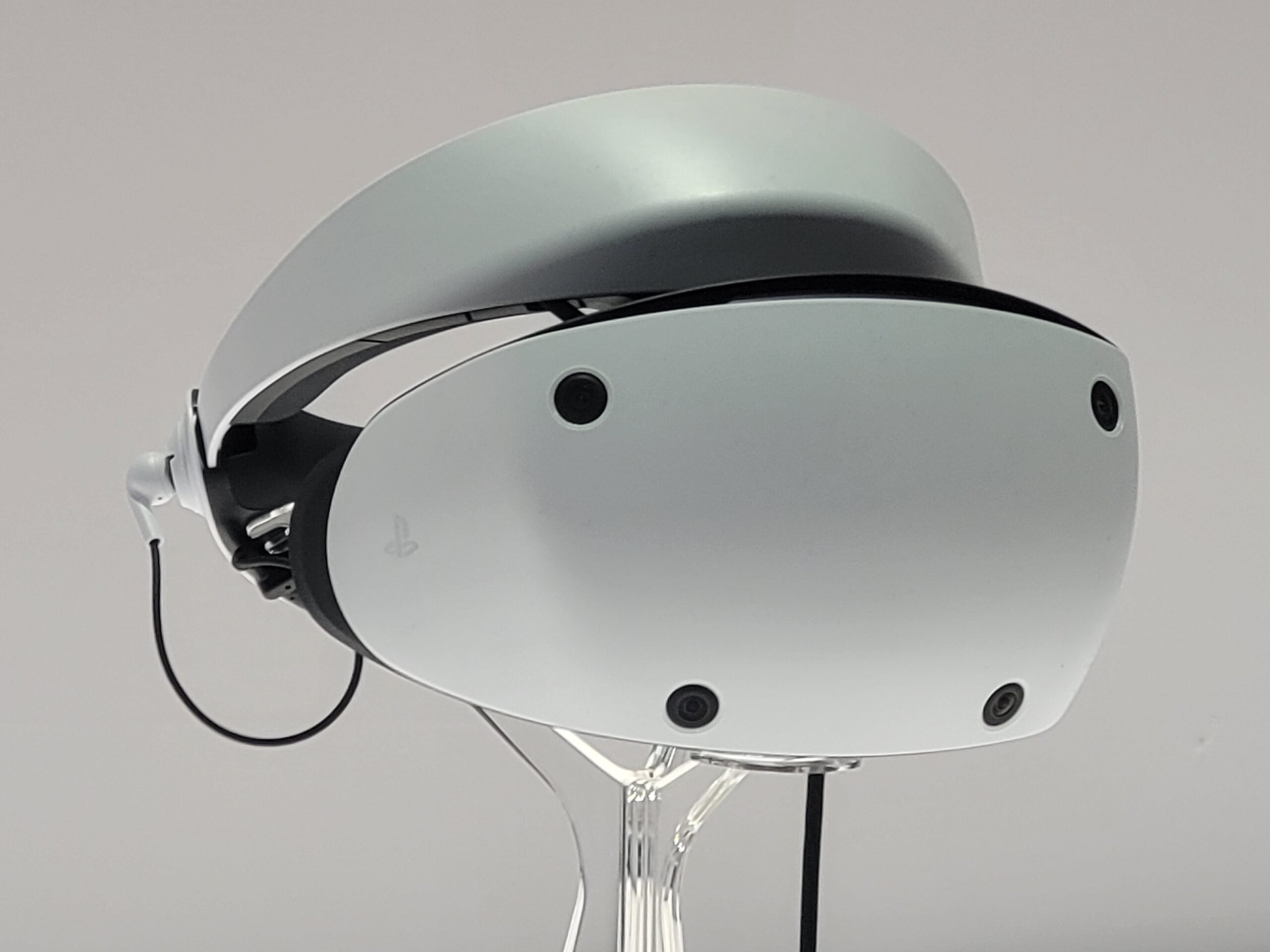The PlayStation VR 2 is a substantial upgrade on its predecessor, with a high-resolution OLED display, more ergonomic controllers and numerous advanced features such as eye tracking.
Key Features
-
High-resolution OLED display:With an OLED display and 2000 x 2040 per eye resolution, the PSVR 2 offers increidble picture quality. -
New Sesne controllers:Ergonomic controllers with motion sensors and haptic feedback. -
Requires a PS5 to function:It can’t run indepedently like the Meta Quest 2 and Pico 4.
I have to admit, I was very pessimistic about the PlayStation VR 2 before trying it for myself. Its high price and need to be plugged into a PS5 meant that it faced an uphill battle to challenge existing headsets such as the Meta Quest 2 and Pico 4.
But then I was given the opportunity to try out the PSVR 2 at CES 2023, and I came away seriously impressed – this could be one of the very best VR headsets I’ve ever used.
The OLED display looked fantastic, the haptic feedback was incredibly immersive and the eye-tracking technology felt delightfully futuristic. Factor in the more ergonomic controllers, and there’s no doubt that this is a massive upgrade on the original PSVR.
I was able to spend 30 minutes with the PSVR 2 while playing the launch title Horizon Call of the Mountain. Here are my thoughts.
Price and availability
Sony has confirmed the PlayStation VR 2 will be priced at $549.99 / £529.99 / €599.99 for launch.
It will become available to buy on February 22 this year, with pre-orders open right now.
Design
- Comfortable to wear throughout 30-minute demo
- Just one wire needs to connect to PS5
- Haptic feedback built into headset
Sony’s PlayStation VR 2 has a simple design, with a padded visor at the front, and a halo-shaped strap that wraps snuggly around my head. A dial at the rear will tighten the headset’s fit so it doesn’t slip off your face.
I’m impressed with how comfortable this headset was to wear for 30 minutes – not once did I need to adjust the headset during my 30-minute demo. That’s not only helped by the padding that Sony has used, but also by ensuring the weight is well distributed.

Sony hasn’t needed to worry about installing a battery, as it’s powered through a cable connection to the PS5. But unlike the original PSVR, you only need to plug in one cord – a substantially more streamlined solution than with the first PSVR, which was a nightmare to set up.
The PSVR 2 has haptic feedback built into the headset, which would give my noggin a little rumble whenever a dinosaur walked by in Horizon Call of the Mountain. The vibrations aren’t quite as aggressive as I expected, but offer just enough feedback to boost the immersion.
The built-in cameras of the PSVR 2 ensure you don’t need to set up external sensors for the headset to register your head movements. It all works flawlessly too, whether I was just tilting my head or walking around the play area.
Controllers
- Controllers are now more ergonomic
- Capacitive sensors can detect finger placement
- Haptic feedback similar to PS5 DualSense pad
The biggest reason why I struggle using the original PSVR is because the controllers are so poor, with some experiences even requiring you to use a standard DualShock controller which dilutes the immersion.
The PlayStation VR 2 rectifies this with far more ergonomic pads. Each controller has a couple of buttons up top, triggers at the rear and an analogue stick – they’re very similar to the Quest’s controllers.

The capacitive sensors enable the controllers to detect your finger placement, even when you’re not pressing down on a button. That means you’re able to naturally clench your fist, grab an object or even give another player a thumbs up (or the middle finger).
The user-friendly ergonomics of the Sense controllers ensured I could quickly pick up mechanics such as climbing a ladder or pulling on a bow string. The haptic feedback also gave my hands a little rumble as I pulled back on the bow, releasing the tension as I pinged an arrow across the canyon.
I didn’t spend enough time with the controllers to find out how long they last on a single charge, but you can juice them back up via a USB-C connection.
Performance
- Vibrant high-resolution display
- Eye tracking useful for menu navigation
- Requires a PS5 to function
The OLED display is one of the most impressive aspects of the PlayStation VR 2. Colours look incredibly vibrant, with rich detail thanks to the 2000 x 2040 per eye resolution – that’s almost just as pixel-packed as the $799 Vive Pro 2. As a result, I never noticed the screen door effect during the demo.
The headset offers support for both 90Hz and 120Hz, which should not only ensure fast motion can be displayed clearly but can also help to reduce the risk of motion sickness. I’m excited to see how other developers will make use of this feature.
And thanks to the graphical grunt of the PS5, the PSVR 2 is capable of displaying incredibly detailed worlds. Horizon Call of the Mountain is one of the best looking VR games I’ve ever played. This feels like a blockbuster PS5 title rather than a shallow VR experience.

But the headset’s dependence on the PS5 console means there’s no internal chip. It’s a shame this headset can’t be used independently to run less demanding games, as the wireless freedom is certainly welcome on the Quest 2 and Pico 4.
The PSVR 2 supports advanced technology such as eye tracking, which makes menu navigation considerably easier than waving around a controller. I unfortunately didn’t notice this technology being used for in-game mechanics, but another upcoming VR game – The Dark Pictures: Switchback VR – will reportedly see enemies move every time you blink.
It did take a bit of time to set up the eye-tracking technology however, as the PSVR 2 runs you through a couple of calibration tests to ensure pinpoint accuracy. You only need to set this up once, unless you’re passing it between friends which could then become a little bothersome.
Games
- Horizon Call of the Mountain is a very promising launch game
- Sony planning 30 launch games, including Resident Evil and No Man’s Sky
- Beat Saber confirmed to arrive after launch
I only played 30 minutes of Horizon Call of the Mountain during my time with the PlayStation VR 2, but it was probably my favourite VR experience yet, alongside Half-Life Alyx.
VR provided a better sense of scale for the colossal dinosaurs, whether it was the Tallneck that towered above me and caused the ground to shudder, or the Snapmaw that lurked underneath my boat – the machines were a lot more intimidating here compared to their PS4 and PS5 counterparts.

I was impressed by how interactive the world was too. While in a boat, I was able to dip my hand into the river to cause ripples in the water, and push vines to the side to clear a path. The haptic feedback also provides little vibrations whenever your hand ever comes into contact with an in-game object to increase the level of immersion.
This isn’t just a walking simulator though, as Call of the Mountain features an engaging combat system which requires you to master the bow and learn how to dodge incoming attacks. I can’t wait for launch day to sink my teeth into this game beyond the opening 30 minutes.
Sony has confirmed that 30 games are on track for launch day, including Resident Evil Village and No Man’s Sky. Even Gran Turismo 7 is getting a VR mode. Classic VR games such as Beat Saber are also confirmed to arrive beyond the launch date.

Unfortunately, games from the original PSVR won’t be compatible on the PSVR 2, so you’re going to have to build up your library from scratch. This is very disappointing, but I can see the logistical issues with enabling compatibility when the PSVR 2 uses completely different controllers and features.
The game library is probably Sony’s greatest strength compared to other VR headsets. Meta has been busy acquiring various VR game studios and has already released a few popular exclusives, but it will still be difficult to compete with Sony’s fantastic range of IPs.
First Impressions
The PlayStation VR 2 is one of the best VR headsets I’ve ever used. The high-resolution OLED display provides colourful and vibrant pictures, while the power of the PS5 can run highly detailed worlds with unprecedented levels of immersion. There’s also plenty of potential for features such as eye tracking and the haptic feedback.
The high price will be a stumbling block for many, as will the requirement to be connected to a PS5. But if Sony is able to provide more experience as immersive and engaging as Horizon Call of the Mountain, then the PSVR 2 has the potential to overshadow even the PS5 console itself.
Jargon buster
VR
Virtual reality is the term given to a computer-generated three-dimensional simulation that can be interacted with real-world movement thanks to hardware such as headsets, controllers and gloves.
The PlayStation VR 2 is a substantial upgrade on its predecessor, with a high-resolution OLED display, more ergonomic controllers and numerous advanced features such as eye tracking.
Key Features
-
High-resolution OLED display:With an OLED display and 2000 x 2040 per eye resolution, the PSVR 2 offers increidble picture quality. -
New Sesne controllers:Ergonomic controllers with motion sensors and haptic feedback. -
Requires a PS5 to function:It can’t run indepedently like the Meta Quest 2 and Pico 4.
I have to admit, I was very pessimistic about the PlayStation VR 2 before trying it for myself. Its high price and need to be plugged into a PS5 meant that it faced an uphill battle to challenge existing headsets such as the Meta Quest 2 and Pico 4.
But then I was given the opportunity to try out the PSVR 2 at CES 2023, and I came away seriously impressed – this could be one of the very best VR headsets I’ve ever used.
The OLED display looked fantastic, the haptic feedback was incredibly immersive and the eye-tracking technology felt delightfully futuristic. Factor in the more ergonomic controllers, and there’s no doubt that this is a massive upgrade on the original PSVR.
I was able to spend 30 minutes with the PSVR 2 while playing the launch title Horizon Call of the Mountain. Here are my thoughts.
Price and availability
Sony has confirmed the PlayStation VR 2 will be priced at $549.99 / £529.99 / €599.99 for launch.
It will become available to buy on February 22 this year, with pre-orders open right now.
Design
- Comfortable to wear throughout 30-minute demo
- Just one wire needs to connect to PS5
- Haptic feedback built into headset
Sony’s PlayStation VR 2 has a simple design, with a padded visor at the front, and a halo-shaped strap that wraps snuggly around my head. A dial at the rear will tighten the headset’s fit so it doesn’t slip off your face.
I’m impressed with how comfortable this headset was to wear for 30 minutes – not once did I need to adjust the headset during my 30-minute demo. That’s not only helped by the padding that Sony has used, but also by ensuring the weight is well distributed.

Sony hasn’t needed to worry about installing a battery, as it’s powered through a cable connection to the PS5. But unlike the original PSVR, you only need to plug in one cord – a substantially more streamlined solution than with the first PSVR, which was a nightmare to set up.
The PSVR 2 has haptic feedback built into the headset, which would give my noggin a little rumble whenever a dinosaur walked by in Horizon Call of the Mountain. The vibrations aren’t quite as aggressive as I expected, but offer just enough feedback to boost the immersion.
The built-in cameras of the PSVR 2 ensure you don’t need to set up external sensors for the headset to register your head movements. It all works flawlessly too, whether I was just tilting my head or walking around the play area.
Controllers
- Controllers are now more ergonomic
- Capacitive sensors can detect finger placement
- Haptic feedback similar to PS5 DualSense pad
The biggest reason why I struggle using the original PSVR is because the controllers are so poor, with some experiences even requiring you to use a standard DualShock controller which dilutes the immersion.
The PlayStation VR 2 rectifies this with far more ergonomic pads. Each controller has a couple of buttons up top, triggers at the rear and an analogue stick – they’re very similar to the Quest’s controllers.

The capacitive sensors enable the controllers to detect your finger placement, even when you’re not pressing down on a button. That means you’re able to naturally clench your fist, grab an object or even give another player a thumbs up (or the middle finger).
The user-friendly ergonomics of the Sense controllers ensured I could quickly pick up mechanics such as climbing a ladder or pulling on a bow string. The haptic feedback also gave my hands a little rumble as I pulled back on the bow, releasing the tension as I pinged an arrow across the canyon.
I didn’t spend enough time with the controllers to find out how long they last on a single charge, but you can juice them back up via a USB-C connection.
Performance
- Vibrant high-resolution display
- Eye tracking useful for menu navigation
- Requires a PS5 to function
The OLED display is one of the most impressive aspects of the PlayStation VR 2. Colours look incredibly vibrant, with rich detail thanks to the 2000 x 2040 per eye resolution – that’s almost just as pixel-packed as the $799 Vive Pro 2. As a result, I never noticed the screen door effect during the demo.
The headset offers support for both 90Hz and 120Hz, which should not only ensure fast motion can be displayed clearly but can also help to reduce the risk of motion sickness. I’m excited to see how other developers will make use of this feature.
And thanks to the graphical grunt of the PS5, the PSVR 2 is capable of displaying incredibly detailed worlds. Horizon Call of the Mountain is one of the best looking VR games I’ve ever played. This feels like a blockbuster PS5 title rather than a shallow VR experience.

But the headset’s dependence on the PS5 console means there’s no internal chip. It’s a shame this headset can’t be used independently to run less demanding games, as the wireless freedom is certainly welcome on the Quest 2 and Pico 4.
The PSVR 2 supports advanced technology such as eye tracking, which makes menu navigation considerably easier than waving around a controller. I unfortunately didn’t notice this technology being used for in-game mechanics, but another upcoming VR game – The Dark Pictures: Switchback VR – will reportedly see enemies move every time you blink.
It did take a bit of time to set up the eye-tracking technology however, as the PSVR 2 runs you through a couple of calibration tests to ensure pinpoint accuracy. You only need to set this up once, unless you’re passing it between friends which could then become a little bothersome.
Games
- Horizon Call of the Mountain is a very promising launch game
- Sony planning 30 launch games, including Resident Evil and No Man’s Sky
- Beat Saber confirmed to arrive after launch
I only played 30 minutes of Horizon Call of the Mountain during my time with the PlayStation VR 2, but it was probably my favourite VR experience yet, alongside Half-Life Alyx.
VR provided a better sense of scale for the colossal dinosaurs, whether it was the Tallneck that towered above me and caused the ground to shudder, or the Snapmaw that lurked underneath my boat – the machines were a lot more intimidating here compared to their PS4 and PS5 counterparts.

I was impressed by how interactive the world was too. While in a boat, I was able to dip my hand into the river to cause ripples in the water, and push vines to the side to clear a path. The haptic feedback also provides little vibrations whenever your hand ever comes into contact with an in-game object to increase the level of immersion.
This isn’t just a walking simulator though, as Call of the Mountain features an engaging combat system which requires you to master the bow and learn how to dodge incoming attacks. I can’t wait for launch day to sink my teeth into this game beyond the opening 30 minutes.
Sony has confirmed that 30 games are on track for launch day, including Resident Evil Village and No Man’s Sky. Even Gran Turismo 7 is getting a VR mode. Classic VR games such as Beat Saber are also confirmed to arrive beyond the launch date.

Unfortunately, games from the original PSVR won’t be compatible on the PSVR 2, so you’re going to have to build up your library from scratch. This is very disappointing, but I can see the logistical issues with enabling compatibility when the PSVR 2 uses completely different controllers and features.
The game library is probably Sony’s greatest strength compared to other VR headsets. Meta has been busy acquiring various VR game studios and has already released a few popular exclusives, but it will still be difficult to compete with Sony’s fantastic range of IPs.
First Impressions
The PlayStation VR 2 is one of the best VR headsets I’ve ever used. The high-resolution OLED display provides colourful and vibrant pictures, while the power of the PS5 can run highly detailed worlds with unprecedented levels of immersion. There’s also plenty of potential for features such as eye tracking and the haptic feedback.
The high price will be a stumbling block for many, as will the requirement to be connected to a PS5. But if Sony is able to provide more experience as immersive and engaging as Horizon Call of the Mountain, then the PSVR 2 has the potential to overshadow even the PS5 console itself.
Jargon buster
VR
Virtual reality is the term given to a computer-generated three-dimensional simulation that can be interacted with real-world movement thanks to hardware such as headsets, controllers and gloves.
























